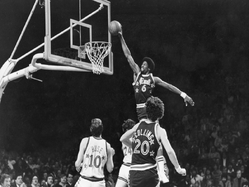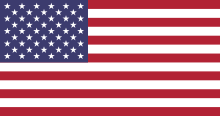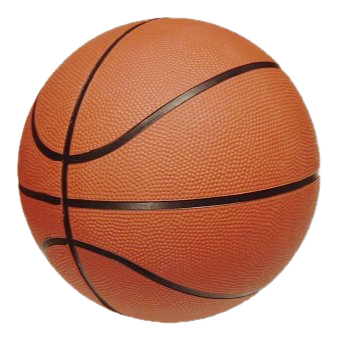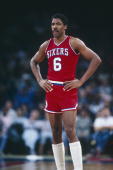 Julius Erving Dunking | |||
| Small Forward | |||
| Jersey #(s): | 32, 6 | ||
Born: February 22,1950 Roosevelt, New York Roosevelt, New York
| |||
| Nationality: | American | ||
| Height: | 6 ft 7 | ||
| Weight: | 210 lbs | ||
| College: | Massachusettes | ||
| Draft: | 12th overall in 1972 by the Milwaukee Bucks | ||
| Pro Career: | 1971-1987 | ||
| Former Teams: | Virginia Squires (1971–1973) New York Nets (1973–1976) Philadelphia 76ers (1976–1987) | ||
| Awards: | * 1x NBA Champion (1983)
| ||
| Hall of Fame Profile: | Info Page | ||
Julius Winfield Erving II (born February 22, 1950) known by his nickname Dr. J, is a retired American professional basketball player and Basketball Hall of Famer. Erving helped legitimize the now-defunct American Basketball Association (ABA). Much as some players are considered "the team," Dr. J was considered "the league." He was the most well-known player in the ABA when the ABA-NBA merger joined it with the National Basketball Association (NBA) after the 1976 season.
Erving won three championships, four Most Valuable Player Awards, and three scoring titles while playing with the ABA's Virginia Squires and New York Nets and the NBA's Philadelphia 76ers. He is the fifth-highest scorer in professional basketball history, with 30,026 points (NBA and ABA combined). He is well-known for slam dunking from the free throw line in Slam Dunk Contests, as well as Michael Jordan.
Erving was named to the NBA's 50th Anniversary All-Time team and in 1993 was inducted into the Basketball Hall of Fame. In 2004, he was inducted into the Nassau County Sports Hall of Fame. Many consider him among the most spectacular basketballers ever, and one of the best dunkers. His signature dunk was the "slam" dunk, since incorporated into the vernacular and basic skill set of the game, in the same manner as the "cross-over" dribble and the "no look" pass.
Career[]
High school and college[]
Erving earned the nickname "Doctor J" in high school, where he displayed a precise method of play for Roosevelt High School Template:Fact.
He enrolled at the University of Massachusetts in 1968. In two varsity college basketball seasons, he averaged 26.3 points and 20.2 rebounds per game, becoming one of only five players to average more than 20 points and 20 rebounds per game in NCAA Men's Basketball.[1]
At that time, professional basketball was in flux, split between two leagues whose players rapidly switched clubs and leagues. Erving joined the ABA in 1971 as an undrafted free agent with the Squires.
Virginia Squires[]
Erving quickly established himself as a force and gained a reputation for hard and ruthless dunking. He scored 27.3 points per game as a rookie, was selected to the All-ABA Second Team, made the ABA All-Rookie Team, and finished second to Artis Gilmore for the ABA Rookie of the Year Award. He led the Squires into the Eastern Division Finals, where they lost to the Rick Barry-led New York Nets.
When he became eligible for the NBA draft in 1972, the Milwaukee Bucks picked him in the first round (12th overall). This move would have brought him together with Oscar Robertson and Kareem Abdul-Jabbar. Instead, the 6'7", 210 pound Erving signed a contract with the Atlanta Hawks before the 1972-73 season.[2] He played three exhibition games with Pete Maravich until, because of a legal injunction, he was obliged to return to the ABA Squires. Back in the ABA, his game flourished, and he achieved a career-best 31.9 points per game. The graceful forward with dazzling people with his flashy, exciting style of play, which fit well with the ABA's up-tempo image.
New York Nets[]
The Squires, like most ABA teams, were on rather shaky financial ground. They were forced to trade Erving to the Nets in 1973--a move which eventually sent the Squires into oblivion. Erving led the Nets to their first ABA title in 1973–74, defeating the Utah Stars. Erving established himself as the most important player in the ABA. His spectacular play established the Nets as, finally, one of the better teams in the ABA, and brought fans and credibility to the league.
1976 finally saw the ABA-NBA merger. The Nets and Nuggets actually applied for admission to the NBA before the season, in anticipation of the eventual merger that had first been proposed by the two leagues in 1970 but delayed for various reasons including the Oscar Robertson suit. The Erving-led Nets defeated the Denver Nuggets in the swan-song finals of the ABA. In the postseason, Erving averaged 34.7 points and was named Most Valuable Player of the playoffs.
In his five ABA seasons, Erving won two championships, three MVP trophies, and three scoring titles.
Philadelphia 76ers[]
The Nets, Denver Nuggets, Indiana Pacers and San Antonio Spurs joined the NBA for the 1976–77 season. With Erving and Nate Archibald (acquired in a trade with Kansas City), the Nets were poised to pick up right where they left off.
However, the New York Knicks threw a monkey wrench into the Nets' plans when they demanded that the Nets pay them $4.8 million for "invading" the Knicks' NBA territory. Coming on the heels of the fees the Nets had to pay for joining the NBA, owner Roy Boe reneged on a promise to raise Erving's salary. Erving refused to play under these conditions and held out in training camp. Boe had little choice but to sell Erving's contract to the Philadelphia 76ers.
Erving quickly became the leader of his new club and took them into the NBA Finals against the Portland Trail Blazers of Bill Walton. After the Sixers took a 2-0 lead, however, the Blazers defeated them with four straight victories. In contrast, the Nets crashed into the cellar.
However, Dr.J enjoyed success off the court, becoming one of the first basketball players to endorse products and to have a shoe marketed under his name. It was at this time that he appeared in television commercials urging young fans asking for his autograph in an airport to refer to him henceforth as "Dr. Chapstick." He also starred in the 1979 basketball comedy film, The Fish That Saved Pittsburgh.
In the following years, Erving coped with a team that was not yet playing at his level. The Sixers were eliminated twice in the Eastern Conference Finals. In 1979, Larry Bird entered the league, reviving the Boston Celtics and the storied Celtics-76ers rivalry; these two teams faced each other in the Eastern Conference Finals for the next four years. The Bird vs. Dr. J matchup became arguably the top personal rivalry in the sport (along with Bird vs. Magic Johnson), inspiring the early Electronic Arts video game Julius Erving-Larry Bird One-on-One.
In 1980, the 76ers prevailed over the Celtics to advance to the NBA Finals against the Los Angeles Lakers. There, Erving executed the legendary Baseline Move, an incredible behind-the-board reverse layup. However, the Lakers won 4-2 with a superb Magic Johnson.
1981 and 1982 were also sour grapes for Erving, as the Sixers stranded twice, once against the Celtics and once again against the Lakers. Nevertheless, Erving was named the NBA MVP in 1981. But for the 1982-83 season, the Sixers obtained the missing element to combat their weakness at their center position, Moses Malone. Armed with one of the most formidable center-forward combinations of all time, the Sixers dominated the whole season, causing Malone to make the famous prediction of "fo-fo-fo (four-four-four)," meaning all the Sixers needed to do was win four games in each series. The media misinterpretedTemplate:Fact the comment and thought he meant the Sixers would sweep the entire playoffs. In fact, the Sixers went four-five-four, losing one game to the Milwaukee Bucks in the conference finals, then sweeping the Lakers to win the NBA title.
Erving maintained his all-star caliber of play into his twilight years, averaging 22.4, 20.0, 18.1, and 16.8 points per game in his final seasons. In 1986, he announced that he would retire after the season, causing every game he played to be sold out with adoring fans.
Career summary[]
Erving retired in 1987. He is one of the few players in modern basketball to have his number retired by two franchises: the New Jersey Nets (formerly the New York Nets) have retired his No. 32 jersey, and the Philadelphia 76ers his No. 6 jersey.
In his ABA and NBA careers combined, he scored more than 30,000 points. In 1993, Erving was elected to the Naismith Memorial Basketball Hall of Fame. When he retired, Erving ranked in the top 5 in scoring (third), field goals made (third), field goals attempted (fifth) and steals (first). On the combined NBA/ABA scoring list, Erving ranked third with 30,026 points. Template:As of, Erving ranks fifth on the list, behind only Kareem Abdul-Jabbar, Karl Malone, Michael Jordan and Wilt Chamberlain.
Post-basketball career[]
After his basketball career, he became a businessman, obtaining ownership of a Coca-Cola bottling plant in Philadelphia and doing work for TV as an analyst. In 1997, he joined the front office of the Orlando Magic.
He and former NFL running back Joe Washington fielded a NASCAR Busch Grand National Series team in the late 1990s, becoming the first ever NASCAR racing team at any level owned completely by minorities. The team had secure sponsorship from Dr Pepper for most of its existence. Erving, a racing fan himself, stated that his foray into NASCAR was an attempt to raise interest in NASCAR among African-Americans.
He has also served on the Board of Directors of Converse (prior to their 2001 bankruptcy), Darden Restaurants, Inc., Saks Incorporated and The Sports Authority.
New Jersey Nets star Vince Carter, who was playing for the Toronto Raptors at the time, preferred Erving as the choice for the team's next General Manager, after Glen Grunwald was dismissed in 2004. However, the team owners hired Rob Babcock instead.
He was ranked #10 on SLAM Magazine's Top 75 NBA Players of All Time in 2003.
Erving is the father of professional tennis player Alexandra Stevenson.[3]
NBA statistics[]
Games - 836; Field Goal % - .507; Rebounds - 5,601; Assists - 3,224; Total Points - 18,364; Points per game [PPG] - 22.0
Memorable feats[]
Although dunking from the foul line had been done by other players (Jim Pollard and Wilt Chamberlain in the 1950s, for example), Erving introduced the dunk jumping off the foul line to a wide audience, when he demonstrated the feat in the 1976 ABA All-Star Game Dunking Contest. He is revered for his legacy of amazing acrobatic and powerful offensive moves.
The Baseline Move[]
One of his most memorable plays occurred during the 1980 NBA Finals, when he executed a seemingly impossible finger-roll behind the backboard.[4] He drove past a defender on the right baseline and went up for a layup. Then 7'2" center Kareem Abdul-Jabbar crossed his way, blocking the route to the basket and forcing him outwards. In mid-air, it was apparent that Erving would land behind the backboard. But somehow he managed to reach over and score on a right-handed layup despite the fact that his whole body, including his left shoulder, was already behind the hoop. This move, along with his free-throw line dunk, has become one of the signature events of his career.
Rock The Baby over Michael Cooper[]
Another of Erving's most memorable plays came in a 1983 regular season game, after a steal from the Los Angeles Lakers. He came down the court on a fast break and, swinging the ball back and forth before taking off on, as described by sports announcer Chick Hearn, a "Rock The Baby" slam dunk, slung the ball around behind his head and dunked over L.A.'s Michael Cooper. This dunk is generally regarded as one of the greatest dunks of all time.
Quotations[]
- "As a basketball player, Julius was the first to actually take the torch and become the spokesman for the NBA. He understood what his role was and how important it was for him to conduct himself as a representative of the league. Julius was the first player I ever remember who transcended sports and was known by one name, Doctor". -- his coach, Billy Cunningham.
- "I saw that basketball could be my way out and I worked hard to make sure it was."
- "Respect is a lot more important, and a lot greater, than popularity."
- "Here I was, trying to win a championship, and my mouth just dropped open. He actually did that! I thought, 'What should we do? Should we take the ball out, or should we give him the ball back and ask him to do it again?' It's still the greatest move I've ever seen in a basketball game, the all-time greatest." -- Magic Johnson on the Baseline Move.
Influences[]
- Glenn "Doc" Rivers got his nickname while at Marquette University for the "Dr. J" t-shirt he often wore to basketball practice.
- Julius Erving was a hero to famous television star, rapper, and sitcom actor Will Smith.
- Carolina Panthers defensive end Julius Peppers was named after Erving.
- Erving was President Barack Obama's childhood sports hero; as a child, he had his posters up in his room. [5]
In popular culture[]
- Erving was idolized by American rapper Dr. Dre, who even rapped using the alias "Dr. J" for a short time.
- Legendary smooth jazz musician Grover Washington, Jr., a fan of the Philadelphia 76ers, created the song "Let It Flow (For Dr. J)", from the album Winelight, in honor of Erving.
- He is mentioned in the song You Be Illin' on the album Raising Hell by Run-D.M.C.. The subject of the song witnesses a dunk by Dr. J and prompt yells "Touchdown".
- Nintendo NES had a game called "Dr.J vs. Larry Bird" - when he retired the game became "Jordan vs. Bird: One on One."
Family[]
Erving was married to Turquoise Erving from 1972 until 2003. Together, they had four children. Their son, Cory, drowned after driving his vehicle into a pond in 2000. [6]
In 1979, Erving began an adulterous affair with sportswriter Samantha Stevenson, resulting in the 1980 birth of American tennis player Alexandra Stevenson. Although Erving's fatherhood of Alexaanda Stevenson was known privately to the families involved, it did not become public knowledge until Stevenson reached the semifinals at Wimbledon in 1999, the first year she qualified to play in the tournament. Erving had provided financial support for Stevenson over the years, but beyond that, had not been a part of her life. The public disclosure of their relationship did not initially lead to contact between father and daughter. However, in 2008, Stevenson contacted him, and they at last did initiate a further relationship with one another.[7]
In 2003, Erving fathered a second child outside of his marriage, this time with a woman named Dorýs Madden. Julius and Turquoise Erving were subsequently divorced. Julius Erving continued his relationship with Madden, and as of 2008, they remained a couple, and had had two more children together.
References[]
- ↑ NCAA Basketball Records
- ↑ "NBA.com: Julius Erving Bio". NBA Media Ventures, LLC. http://www.nba.com/history/players/erving_bio.html. Retrieved 2008-12-16.
- ↑ Making a splash - After dancing through Wimbledon, the always-smiling Alexandra Stevenson has dedicated herself to rejuvenating her game, by Chris Nicholson published in USTA Magazine, May 2000
- ↑ NBA.com: Doctor’s Shot Stuns Lakers
- ↑ [1] "Barack Obama on sports talk radio, April 2, 2008"
- ↑ Son of Julius Erving died of accidental drowning, CBC Sports
- ↑ Reaching Out

